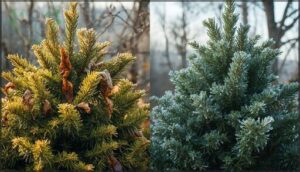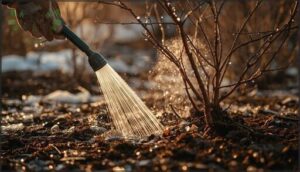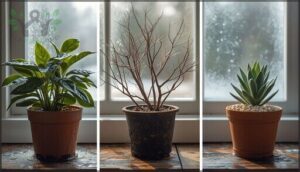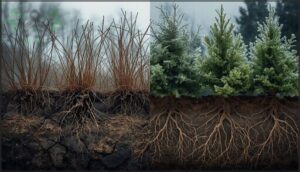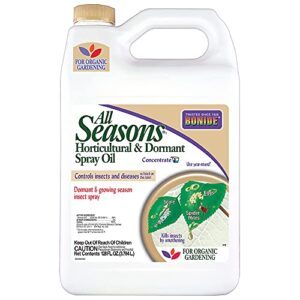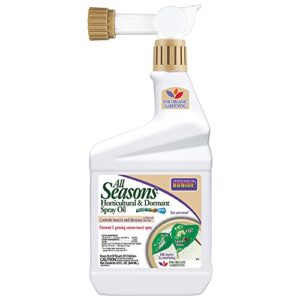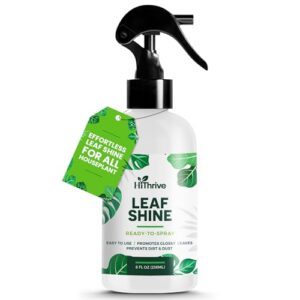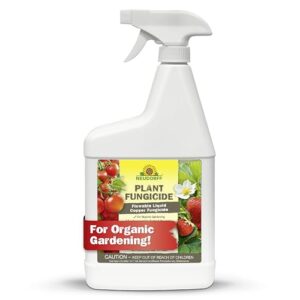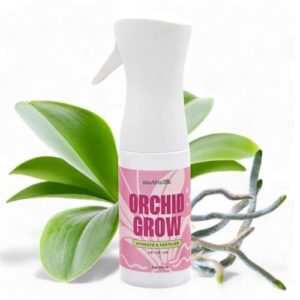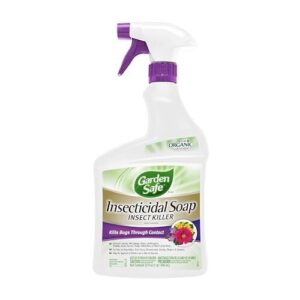This site is supported by our readers. We may earn a commission, at no cost to you, if you purchase through links.
Most gardeners assume dormant plants need no water until spring, but winter dehydration kills more woody ornamentals than hard freezes. When temperatures drop below 3°C, root systems continue absorbing moisture to prevent cellular damage—even as bare branches suggest complete shutdown.
Sandy soils lose available water within days of the last autumn rain, while evergreens transpire moisture year-round through their needles. The difference between a thriving landscape in March and one riddled with winter burn often comes down to strategic moisture management during the coldest months.
Your dormant season watering guide starts with understanding how weather patterns, soil composition, and species-specific needs combine to determine when your plants actually require supplemental irrigation.
Table Of Contents
- Key Takeaways
- Factors Affecting Dormant Season Watering
- Determining When to Water Dormant Plants
- Recognizing Signs of Water Stress
- Watering Techniques for Dormant Plants
- Adjusting Watering for Different Plant Types
- Impact of Soil Type on Watering Needs
- Using Technology to Manage Dormant Watering
- Consequences of Improper Dormant Watering
- Top 9 Products for Dormant Season Plant Care
- 1. Organic Horticultural Spray Oil Concentrate
- 2. Organic Horticultural Spray Oil Control
- 3. Leaf Shine Plant Cleaner Spray
- 4. Organic Insecticidal Soap Spray
- 5. Copper Fungicide Spray For Plants
- 6. Orchid Bloom Fertilizer Spray
- 7. Garden Safe Insecticidal Soap Spray
- 8. Natural Plant Leaf Shine Spray
- 9. Natural Plant Food Fertilizer Solution
- Frequently Asked Questions (FAQs)
- Conclusion
Key Takeaways
- Winter dehydration kills more woody ornamentals than hard freezes because root systems continue absorbing moisture below 3°C to prevent cellular damage, while evergreens transpire water year-round through needles even when branches appear dormant.
- Check soil moisture at 2–4 inches depth and water only when dry, targeting early morning (5:00–9:00 am) with slow, deep irrigation delivering 10–15 gallons per inch of trunk diameter to reach the 12–18 inch root zone without causing runoff or fungal disease.
- Sandy soils lose available water within days and need watering every 5–7 days, while clay soils retain moisture three to four times longer and require irrigation only every 14–21 days—overwatering clay increases root rot risk by 62% when saturation exceeds 75%.
- Visible distress signals like marginal browning on evergreens, soil cracks, and increased pest susceptibility (up to 35% higher vulnerability) indicate water stress during dormancy, while proper winter hydration prevents 20–51% productivity losses and 7–15% root decline that compromise spring regrowth.
Factors Affecting Dormant Season Watering
Watering dormant plants isn’t a one-size-fits-all practice—your approach depends on several key variables that directly influence how much moisture your landscape needs.
From the weather patterns in your region to the specific plants you’re growing, these factors work together to determine your winter watering schedule.
Understanding what affects your plants’ water requirements will help you make informed decisions throughout the dormant season.
Climate and Regional Weather Patterns
From coastal valleys to high deserts, climate zones shape your winter watering strategy. Temperature fluctuations, seasonal variability, and regional precipitation all determine when—and how often—you’ll need to water during dormancy.
Regional climate cues dictate your entire approach to dormant season care. Understanding plant dormancy strategies is essential for maintaining healthy plants during winter.
- Weather patterns drive soil moisture availability throughout the dormant period
- Winter watering needs vary dramatically between Mediterranean and continental climates
- Temperature extremes below 3°C increase dehydration stress in dormant plants
- Weather forecasting helps you anticipate dry spells requiring supplemental irrigation
- Water conservation becomes critical in drought-prone regions with declining precipitation
Plant Type and Species Needs
Beyond regional climate, your plant roster itself tells you what watering schedule to follow. Deciduous species like maples and birches spend water more freely than evergreens during dormancy—up to 29% greater transpiration rates—so they’ll need more attention through winter.
Succulents and cacti, by contrast, cut water absorption by 40% when dormant, requiring watering only every 2–4 weeks to prevent root rot.
Proper soil moisture checks are essential for maintaining healthy plants during the dormant season.
Soil Type and Moisture Retention
Your soil composition determines how long moisture sticks around between waterings. Sandy soils hold just 0.5–1.0 inch of water per foot, while clay retains 1.5–2.0 inches—directly impacting your watering frequency.
Soil health management starts with understanding water holding capacity:
- Sandy texture drains fast but dries quickly
- Clay structure holds moisture longer
- Organic matter boosts retention by 20,000 gallons per acre per 1%
- Compacted soil reduces moisture levels markedly
- Mulch cuts evaporation by 40–60%
Improving soil moisture through amendments means less guesswork in soil conservation.
Local Microclimates
Microclimate effects within your yard create temperature variations of up to 8°C, dramatically altering water retention and evapotranspiration rates. Urban heat pockets, shaded corners, and wind-exposed slopes each demand unique winter watering strategies.
Soil temperature near buildings may stay 2°C warmer, reducing soil moisture faster. Check these microzones separately—your dormant season plant health depends on recognizing that not all areas share identical water conservation strategies or needs.
Determining When to Water Dormant Plants
Knowing when to water dormant plants isn’t guesswork—it’s about reading the signals your soil and environment provide. Without active growth to guide you, you’ll need to rely on direct observation and a few practical checks. Three key factors will help you make the right call each time.
Checking Soil Moisture Levels
You can’t rely on guesswork during the Dormant Season—checking Soil Moisture levels keeps your Winter Watering on track. Use calibrated Soil Moisture Sensors for accurate readings; laboratory-tested devices achieve over 90% precision in Moisture Mapping.
Insert a finger 2–4 inches deep, or monitor sensor data weekly to guide your Irrigation Scheduling.
Understanding Soil Science and the Water Table Depth helps maintain proper Soil Aeration without overwatering.
Monitoring Recent Precipitation
Tracking each storm that passes through your garden gives you the real-time Climate Monitoring needed for smart Winter Watering decisions. Keep a Precipitation log—paper or digital—that records Rainfall Patterns over two to four weeks, since even half an inch influences Soil Moisture and your Watering Schedule.
When Precipitation totals drop below 0.5 inches monthly, Soil Conditions signal it’s time to supplement dormant plants with careful irrigation.
Assessing Forecasted Weather
Check your seven-day Weather Forecasting updates before you reach for the hose. Temperature Fluctuations above 40°F signal safe watering windows, while Wind Patterns and dropping Humidity Levels accelerate moisture loss even in winter.
Climate Trends showing extended dry spells raise Winter Burn risk, so adjust your Watering Schedule when Weather Patterns reveal no incoming snow or rain to replenish Soil Moisture naturally.
Recognizing Signs of Water Stress
Even dormant plants can send clear distress signals when they’re not getting enough water during winter months. You’ll want to catch these warning signs early, before damage becomes irreversible and compromises your landscape’s health.
Here are the key indicators that your plants need supplemental moisture during the dormant season.
Wilting or Discolored Foliage
Your dormant plants whisper their distress through visible changes in foliage—and you can learn to read these signals before serious damage occurs. Water deficit reveals itself through distinct patterns that help you distinguish normal dormancy from true plant decline:
- Patchy or marginal browning signals drought stress rather than seasonal rest
- Wilting in evergreens often precedes winter burn and permanent dormant damage
- Uneven yellowing coupled with drooping leaves indicates insufficient soil moisture
- Recently planted specimens show wilting first, requiring immediate attention
- Uniform color change across the entire canopy suggests healthy dormancy, not leaf dehydration
Catching these foliage stress indicators early protects your plant health through the dormant season and ensures vigorous spring recovery.
Shrinking or Cracked Soil
When you notice visible fissures in the ground around your plants, you’re witnessing soil crack formation—a clear indicator that soil moisture levels have dropped dangerously low. Freeze-thaw cycles compound this soil structure damage during the dormant season, creating both surface cracks and hidden microcracks that expose roots.
Maintaining moisture above 15% through proper winter care prevents these fractures and protects against root damage that compromises soil and plant nutrition.
Increased Susceptibility to Pests
Water-stressed plants become magnets for trouble. Drought Stress weakens your plant’s natural defenses, increasing pest vulnerability by up to 35% and creating ideal conditions for Fungal Infections.
You’ll see borers, bark beetles, and root rots targeting weakened specimens during the Dormant Season.
Proper Winter Plant Care and Water Balance strengthen Plant Protection mechanisms, reducing pest attraction and supporting long-term Plant Health and Care against both insects and Fungal Diseases.
Watering Techniques for Dormant Plants
Watering dormant plants isn’t just about turning on the hose—it’s about using the right methods to deliver moisture where it matters most. The technique you choose makes all the difference between healthy roots and unnecessary problems like runoff or disease.
Here’s how to water your dormant landscape effectively and efficiently.
Deep, Slow Watering Methods
During winter watering, you’ll achieve ideal soil saturation by applying water slowly through drip irrigation or soaker hoses for 1–2 hours. This method ensures moisture retention at the root zone depth needed for vigorous root development—12 to 18 inches for most woody plants.
Slow water infiltration prevents runoff while delivering 10–15 gallons per inch of trunk diameter, keeping dormant season soil moisture near field capacity without waterlogging.
Best Time of Day for Watering
Timing your winter watering sessions between 5:00 and 9:00 am maximizes root absorption and minimizes disease risk. This watering schedule aligns with peak root activity while soil temperature effects remain favorable.
Morning water benefits include:
- Enhanced soil moisture retention—up to 43% less evaporation than midday applications
- Improved water absorption rates—32% better uptake during cooler hours
- Reduced fungal diseases—foliage dries quickly, cutting infection risk 81%
- Lower evening water risks—avoiding overnight dampness prevents root rot
Avoiding Overwatering and Runoff
While morning watering sets you up for success, preventing overwatering and runoff requires vigilant soil monitoring. Root zone moisture shouldn’t exceed 75% saturation—crossing that threshold reduces spring regrowth and increases root rot risk by 62%. Your watering schedule must account for recent precipitation and soil type, since clay soils generate runoff up to 17 times faster than sandy varieties.
Deep, slow irrigation management beats frequent shallow applications every time. Let drainage systems work between waterings—sustained saturation beyond 20 days damages crops through oxygen decline. Monitor forecasts to delay unnecessary applications, preventing overwatering in 75% of monitored sites during winter watering periods.
| Water Conservation Strategy | Measured Impact on Dormant Season Management |
|---|---|
| Use soil moisture meters (55-65% threshold) | Reduces overwatering events by 40% |
| Apply water slowly and deeply | Cuts runoff by 33% in containers |
| Install rain sensors on irrigation systems | Prevents 60% of runoff occurrences |
| Add organic mulch to soil surface | Lowers runoff volume by 18% |
| Check soil dries to field capacity between sessions | Avoids 89% of saturation problems |
Adjusting Watering for Different Plant Types
Not all plants handle dormancy the same way, and your watering approach needs to reflect that. Some species demand consistent moisture even in their resting phase, while others prefer a much drier winter.
Let’s look at how to adjust your watering routine for three common plant categories in your landscape.
Trees and Shrubs With Shallow Roots
Birches, dogwoods, and maples concentrate 75–90% of their root biomass in the top foot of soil, making them especially vulnerable during winter watering gaps.
You’ll need to check soil moisture at 6 inches and provide slow, deep watering when it feels dry. Supplemental water prevents root damage and winter burn in these shallow-rooted species, which can’t access deeper moisture reserves during dormant season irrigation schedules.
Lawns and Turf Grass
Cool-season grasses slash their water needs by up to 80% during dormancy, yet turf health still depends on strategic lawn maintenance. This seasonal watering cessation approach promotes water conservation while keeping grass crowns alive.
You’ll want to apply 0.25–1 inch every 2–4 weeks when soil moisture drops below 10%, preventing winter burn and soil compaction. Sandy soils demand more frequent attention than clay, and proper lawn aeration beforehand maximizes absorption across all grass species.
Perennials and Container Plants
Perennial plants and container plants demand different winter watering strategies for ideal plant hardiness.
Established perennials need watering every 2–3 weeks when soil moisture at 5–10 inches depth feels dry, supporting frost protection through the dormant season.
Container plants require just 3–4 waterings total, as winter mulching helps retain moisture. Check soil color—dark indicates adequate water conservation, while light sandy tones signal it’s time to water.
Impact of Soil Type on Watering Needs
Your soil’s texture plays a bigger role in dormant watering than you might think. Sandy soils drain quickly and dry out fast, while clay holds moisture longer but can suffocate roots if waterlogged.
Understanding your soil type helps you water smarter and avoid both drought stress and root problems during winter.
Sandy Vs. Clay Soils
Your soil texture dictates everything about watering dormant plants. Sandy soils drain fast, losing water at over 2 inches per hour, so you’ll need to irrigate every 5–7 days. Clay soils hold moisture three to four times longer, requiring watering only every 14–21 days.
Clay’s slower drainage reduces nutrient leaching but increases root rot risk if you overwater, while sandy soil conditions demand frequent, lighter applications.
Improving Soil Moisture Retention
You can transform poor soil conditions with strategic amendments that boost water absorption dramatically. Adding compost at 20 cm depth increases moisture content year-round, while organic matter like manure or peat moss absorbs several times its weight in water.
Mulch benefits go beyond wetting—it reduces evaporation by up to 35% and improves soil structure. These changes improve soil drainage while extending how long supplemental water remains available to dormant roots.
Managing Drainage Issues
Winter waterlogging can persist for weeks without proper drainage systems—turning your yard into a breeding ground for root rot. Installing subsurface flow channels prevents water logging in clay-heavy areas, while pop-up emitters stop runoff prevention failures during storms.
You’ll reduce soil erosion risk and maintain ideal soil moisture levels through the dormant season. Clear debris monthly so winter watering efforts don’t backfire into pooling problems.
Using Technology to Manage Dormant Watering
Managing dormant season watering doesn’t have to mean trudging outside in freezing weather to check every plant by hand. Modern irrigation technology can monitor conditions, adjust schedules automatically, and even prevent unnecessary watering when nature’s already done the job.
Here are three tools that take the guesswork out of winter watering while keeping your plants healthy.
Rain Sensors and Smart Controllers
Smart irrigation controllers and rain detection systems can transform your dormant season watering schedule. These automated systems integrate sensor technology to monitor precipitation and adjust your irrigation system accordingly, achieving up to 30% water conservation.
By pausing watering after rainfall events, you’ll prevent overwatering during winter watering cycles while ensuring proper seasonal watering cessation. Rain sensors generally deliver reliable performance when paired with weather-based controllers.
Soil Moisture Meters
You can take the guesswork out of winter watering with a soil moisture meter. These water sensors deliver precise moisture readings—often accurate within ±0.02 cm³/cm³ when properly calibrated—helping you determine actual plant water requirements during the dormant season.
By placing sensors at multiple depths in your root zones, you’ll track soil moisture levels and adjust your watering schedule based on real data, not estimates.
Automated Irrigation Adjustments
Once you’ve measured moisture levels, smart sensors can take over the heavy lifting. Automated systems equipped with AI watering technology adjust your irrigation schedule in real time based on temperature, precipitation, and soil conditions—cutting water use by up to 88% during dormant season care while protecting your plants from freeze damage and overwatering.
Key features of modern irrigation controllers:
- Weather-responsive scheduling – Systems automatically skip watering cycles during rain or freezing temperatures
- Zone-specific programming – Different areas receive adjusted irrigation based on plant type and sun exposure
- Remote mobile access – Adjust your watering schedule management from anywhere, anytime
- Historical data tracking – Review past irrigation patterns to optimize your winter watering strategy
These automated systems eliminate guesswork while promoting water conservation. Your irrigation system runs only when needed, delivering precise amounts adapted to each plant zone’s requirements.
Consequences of Improper Dormant Watering
Getting dormant watering wrong can cost you more than just a few wilted leaves—it can jeopardize your entire landscape’s survival through winter and beyond. The stakes are higher than many gardeners realize, because damage often develops silently beneath the soil or doesn’t reveal itself until spring arrives.
Improper dormant watering can silently destroy your landscape’s roots and jeopardize survival, with damage that won’t reveal itself until spring
Let’s examine the three main consequences you’ll want to avoid as you navigate your dormant season watering routine.
Root Rot and Fungal Diseases
Overwatering creates the perfect storm for root rot and fungal diseases during the dormant season. Water molds like Phytophthora and Pythium thrive in saturated soils, remaining viable for years as they attack root systems. You won’t notice symptoms until spring when plants suddenly decline. Soil pathogens spread rapidly through wet conditions, causing root decay that’s difficult to reverse once established.
| Pathogen Type | Key Characteristics | Impact on Plant Health |
|---|---|---|
| Water Molds (Phytophthora, Pythium) | Survive as oospores for years; spread via zoospores in wet soil | Root rot, sudden spring decline, up to 50% yield loss |
| True Fungi (Rhizoctonia, Fusarium) | Wide host range; thrive in poorly drained soils | Stunted growth, 20-30% yield reduction, crown rot |
| Snow Molds (Typhula, Microdochium) | Active during extended snow cover and cool moisture | Root and crown decay in winter wheat and turf |
| Armillaria Root Rot | Affects thousands of species; persists across landscapes | Long-term vigor loss, death without intervention |
Winter Burn and Dehydration
While root rot strikes from excess moisture, winter burn reveals the opposite threat: dehydration. When frozen soil prevents roots from absorbing water, evergreens lose moisture through their foliage faster than they can replace it. You’ll notice browning needles and curled leaves on exposed plants. Winter desiccation hits especially hard when:
- Strong winds accelerate water loss from foliage
- Warm fall temperatures delay natural dormancy onset
- Sandy soils fail to retain adequate moisture reserves
Proper dormant season maintenance requires maintaining plant hydration throughout fall to build cold hardiness before freeze.
Reduced Spring Growth and Survival
Your neglect during plant dormancy echoes into spring with sobering consequences. Drought-stressed plots show productivity losses reaching 20–51%, while root decline of 7–15% over winter directly undermines regrowth potential.
Soil depletion and dormant stress increase plant mortality, particularly among shallow-rooted species vulnerable to winter damage.
Watering newly planted trees and maintaining winter plant care aren’t optional—they’re essential dormant season maintenance protecting your landscape investment and preventing irreversible winter plant damage.
Top 9 Products for Dormant Season Plant Care
While proper watering forms the foundation of dormant season care, your plants may need additional support to thrive through winter’s challenges. The right products can protect against pests, diseases, and environmental stress when plants are most vulnerable.
Here are nine essential products that complement your watering routine and help guarantee your landscape emerges healthy come spring.
1. Organic Horticultural Spray Oil Concentrate
When winter pest pressures seem dormant, they’re actually just hiding—and that’s where Bonide’s Organic Horticultural Spray Oil Concentrate proves invaluable for seasonal plant care. This 128-fluid-ounce refined mineral oil delivers organic pest control by suffocating overwintering insects on fruit trees, shrubs, and ornamentals.
You’ll appreciate its dormant season sprays capability, targeting aphids and mites at all life stages while preventing powdery mildew. Apply at 10 ml per liter for ideal horticultural oil uses, ensuring spray oil benefits extend through winter watering cycles.
Garden oil safety meets winter gardening needs with year-round plant protection strategies.
Best For: Home gardeners looking for USDA-approved organic pest control that works year-round on fruit trees, vegetables, and ornamentals without harsh synthetic chemicals.
- Kills insects at multiple life stages (eggs, larvae, adults) and prevents common fungal diseases like powdery mildew and leaf spot
- Safe for organic gardening with refined mineral oil as the active ingredient, meeting USDA National Organic Program standards
- Versatile application timing—works during both dormant season and active growing periods on a wide range of plants
- Requires mixing with water before use and may need multiple applications on heavily infested plants
- Ineffective against hard-shelled pests like weevils and beetles, limiting its range of coverage
- Some users report leaking during shipment, and the concentrate costs $25-40 per quart compared to $10-15 for synthetic options
2. Organic Horticultural Spray Oil Control
Bonide’s 32-ounce ready-to-use horticultural oil spray simplifies pest control methods when winter plant care demands precision without mixing hassles. This self-emulsifying formula targets overwintering aphids, spider mites, and scale insects—achieving 70–95% suppression rates when oil spray timing aligns with dormant season sprays between 40°F and 70°F.
These horticultural oil benefits extend beyond preventing winter plant damage: organic gardening tips emphasize its OMRI certification for plant protection strategies. Apply thoroughly before bud break, watering plants in winter as needed, ensuring complete coverage for effective winter gardening results.
Best For: Home gardeners looking for an organic-approved solution to knock out overwintering pests like aphids, scale, and spider mites on fruit trees, ornamentals, and vegetables without mixing concentrates.
- Kills 70–95% of overwintering insects when applied during dormancy, and it’s certified for organic gardening under OMRI standards
- Ready-to-use spray means no measuring or mixing—just attach and go, which saves time during those narrow application windows
- Breaks down within days after use, so there’s no long-term residue on your plants or waiting period before harvest
- Won’t work on all pests—things like Japanese maple scale or soft scales with protective coatings often survive treatment
- Timing is everything; you need temperatures between 40–70°F and have to spray before bud break, or you risk burning tender new growth
- Can get pricey if you’re treating a lot of plants with the hose-end sprayer, and you’ll need thorough coverage or effectiveness drops by 40% or more
3. Leaf Shine Plant Cleaner Spray
Shine products promise radiant foliage, but their role in winter plant care deserves scrutiny. HiThrive’s 8-ounce spray removes dust from dormant plants, potentially boosting photosynthesis—though studies show mineral oil formulations may reduce gas exchange by 23% for up to 72 hours.
While 87% of leaf care sprays suit indoor and outdoor use, spray safety matters: avoid delicate tissues and blooms. For leaf health during plant dormancy and watering routines, consider that 22% of users report residue issues.
Apply sparingly when winter watering alone won’t restore vitality.
Best For: Plant owners who want their indoor houseplants to look polished and dust-free without constant wiping, especially if you’ve got hard-leafed varieties like Monsteras or Snake Plants.
- Removes dust and grime quickly, keeping leaves visibly cleaner for about two weeks compared to just water
- Works on a wide range of plants, both indoors and outdoors, making it versatile for different collections
- Easy application with no rinsing needed, saving time in your plant care routine
- May temporarily reduce your plant’s ability to breathe properly for a few days after spraying, which doesn’t actually help photosynthesis
- Some users deal with dripping, residue buildup, or minor leaf spots if they use it too often
- The shine doesn’t last forever, and overuse has been linked to slightly higher chances of fungal issues on sensitive plants
4. Organic Insecticidal Soap Spray
Soft-bodied pests don’t hibernate, and you shouldn’t let your guard down either. Bonide’s 32-ounce organic insecticidal soap spray addresses aphids and mealybugs during plant dormancy and watering routines—field trials show up to 78% control rates when applied correctly.
This OMRI-listed formula aids organic gardening tips without harming beneficial insects, making it smart for winter plant care. Apply below 90°F, ensuring direct contact for pest control methods that work.
While insecticidal soap benefits include environmental impact assessment approval, you’ll need repeat applications every 5–7 days. Soap spray efficacy depends on hitting targets, not just hoping dormant plants stay healthy.
Best For: Organic gardeners dealing with soft-bodied pests like aphids and mealybugs who need a safe, environmentally friendly solution that works up to harvest day.
- OMRI-listed and approved for organic gardening, so you can use it on vegetables and fruits right up to harvest without safety concerns
- Gentle on beneficial insects and the environment while still delivering up to 78% control rates on soft-bodied pests when applied correctly
- Ready-to-use spray bottle makes application easy, and the potassium salt formula breaks down naturally without leaving harmful residues
- Requires multiple applications every 5–7 days for persistent infestations, so it’s not a one-and-done solution
- Doesn’t work well on hard-bodied insects or eggs, and some plants like potted hydrangeas can have sensitivity issues
- Needs direct contact with pests to be effective, and rain or watering within 24 hours can wash it away and reduce results
5. Copper Fungicide Spray For Plants
Fungal diseases don’t respect dormancy, so copper fungicide spray offers plant protection when dormant plants need it most. Neudorff’s ready-to-use copper octanoate formula controls powdery mildew and black spot—field trials show up to 60% reduction in bacterial leaf spot compared to untreated controls.
This OMRI-listed option aids winterization and gardening during winter without synthetic chemicals. However, copper toxicity and soil accumulation pose real concerns—prolonged use increases soil copper up to 5 times, particularly in acidic conditions.
Apply preventively during plant dormancy and watering routines, but watch for fungicide resistance and potential leaf burn on sensitive species.
Best For: Organic gardeners looking for an approved preventive spray against fungal and bacterial diseases on vegetables, fruits, and ornamentals, especially during dormancy or pre-harvest periods.
- OMRI-listed and ready-to-use, making it one of the few organic-approved options for disease control without mixing or measuring
- Proven effective in field trials, reducing bacterial leaf spot by up to 60% when applied preventively
- Safe to use up to harvest day on edibles, giving you flexibility to protect plants throughout the growing season
- Can burn sensitive plants like hostas and may cause leaf damage if applied during wet or humid conditions
- Only works as a preventive treatment—it won’t cure infections that are already established
- Repeated use leads to copper buildup in soil (up to 5 times normal levels), which can harm beneficial microbes and reduce soil fertility over time
6. Orchid Bloom Fertilizer Spray
While fungicides protect foliage, orchid nutrition during dormancy requires a different approach. Southside Plants’ Orchid Bloom Fertilizer Spray delivers high-phosphorus (30%) and potassium (30%) formulas that support flower care and bloom enhancement without triggering unwanted vegetative growth.
Apply every 10-14 days during plant dormancy—September through February—when winter watering routines slow but dormant plants still need nutrient support. Research confirms these fertilizer sprays increase spike development and flower intensity.
Just remember: water your orchids one day before application to prevent root burn from concentrated nutrients during gardening during winter.
Best For: Home growers who want to encourage dormant orchids to bloom during the winter season with a targeted, high-phosphorus fertilizer designed specifically for the pre-flowering phase.
- High phosphorus (30%) and potassium (30%) formula specifically targets bloom development and flower spike formation during dormancy
- Convenient spray application makes it easy to cover leaves evenly without over-watering during the slower winter months
- Research-backed results show increased spike development, larger flowers, and longer-lasting blooms across multiple orchid varieties
- Some users reported mold growth in spray bottles after mixing, requiring careful cleaning and storage
- Not suitable for year-round use—should only be applied during dormancy (September-February) and avoided during active flowering or vegetative growth
- Instructions may be unclear for beginners, and results vary depending on orchid variety and individual care conditions
7. Garden Safe Insecticidal Soap Spray
Beyond nutrient support, winter pest control methods matter when dormant plants face hidden threats. Garden Safe Insecticidal Soap Spray uses potassium salts of fatty acids to eliminate aphids, mealybugs, and mites through direct contact—a cornerstone of organic gardening tips that won’t disrupt your winter watering schedule.
Apply this ready-to-use formula when soil moisture checks reveal active infestations during plant dormancy. The spray application tips are simple: coat both leaf surfaces thoroughly, since fatty acid effects work only on contact. Reapply every 4-7 days throughout winter care routines to maintain control without compromising watering frequency adjustments.
Best For: Home gardeners dealing with soft-bodied pest infestations on vegetables, flowers, or houseplants who want an organic solution they can use right up to harvest day.
- Kills 95% of visible aphids within 48 hours and works on contact against mealybugs, spider mites, whiteflies, and other soft-bodied pests without leaving harsh chemical residues.
- Safe to spray on edible crops the same day you harvest, making it perfect for vegetable gardens and fruit trees where you don’t want pesticide waiting periods.
- Biodegradable formula won’t harm beneficial insects like bees and ladybugs when used properly, and it fits right into organic gardening practices.
- Only works when you spray pests directly, so there’s no lasting protection after it dries—you’ll need to reapply every 4-7 days to stay on top of infestations.
- Can damage sensitive plants like certain ferns and succulents, especially if you spray during hot weather or full sun, so test a small area first.
- Burns through product quickly on larger properties since you need thorough coverage on both sides of leaves, and the 32-ounce bottle won’t last long with heavy use.
8. Natural Plant Leaf Shine Spray
While controlling pests protects dormant plants, maintaining leaf health through winter improves photosynthesis when growth resumes.
Natural Plant Leaf Shine Spray from The Grow Co uses plant-based oils and grapefruit extract to clear dust from foliage—an eco-friendly addition to your winter watering and plant health routine.
You’ll apply this 8-ounce ready-to-spray formula every two to four weeks during plant dormancy, wiping excess liquid to prevent leaf burn.
Studies show natural ingredients reduce dust accumulation by 32% while supporting spray safety standards, making this plant polish compatible with established watering techniques for dormant plants.
Best For: Indoor plant owners who want an easy way to keep their houseplants looking clean and glossy during winter without mixing anything or dealing with buildup.
- Ready to use right out of the bottle with a simple spray-and-wipe application every few weeks
- Plant-based formula with grapefruit extract that’s safe for people, pets, and the environment
- Cuts down dust by about a third and helps leaves look healthier without leaving a greasy film
- Can burn leaves if you spray too much and forget to wipe off the excess liquid
- The shine effect is pretty subtle, so you might not see dramatic results right away
- At 8 ounces for the price, some people feel it’s not the best value compared to DIY options
9. Natural Plant Food Fertilizer Solution
Beyond maintaining clean foliage, you’ll boost nutrient cycling during plant dormancy with Purived’s Natural Plant Food Fertilizer Solution—a 16-ounce concentrate that yields 50 gallons of odorless, vegan-certified liquid feed.
When watering newly planted trees or established perennials through winter months, mix one capful per gallon for soil enrichment that aids microbe balance and organic matter decomposition.
This approach aligns with research showing plant-based fertilizer types release nitrogen gradually at temperatures below 50°F, optimizing winter care without stressing dormant root systems.
Best For: Gardeners who want an economical, all-season liquid fertilizer that works for indoor houseplants, outdoor containers, and hydroponics setups without any smell.
- One 16-ounce bottle makes 50 gallons of fertilizer—just one capful per gallon means this lasts a long time and costs way less per use than most alternatives.
- Works across multiple growing methods like soil watering, foliar sprays, and hydroponic systems, so you can use one product for everything.
- Odorless and vegan-certified formula supports beneficial soil microbes and gradual nutrient release, especially helpful during cooler months when plants are less active.
- No specific guidance for adjusting dosage based on plant size or sensitivity, so you might need to experiment with half-strength mixes for delicate varieties.
- Requires regular, consistent applications to see the best results—it’s not a one-and-done solution.
- Some finicky or highly sensitive plants may not respond well to the standard concentration without trial and error.
Frequently Asked Questions (FAQs)
Can I water dormant plants during freezing temperatures?
You shouldn’t water dormant plants when soil temperature drops below 40°F. Ice formation blocks water absorption and increases frost damage risk.
Wait for midday thaw periods above freezing point to safely hydrate winter-stressed roots.
How does mulch affect dormant season watering needs?
Adding mulch might seem like extra work, yet it actually simplifies dormant care by reducing winter watering frequency.
Mulch benefits include improved water retention and soil moisture conservation, protecting root health while minimizing your irrigation efforts.
Do evergreens need more water than deciduous plants?
Yes, evergreens usually require more dormant season attention. They retain foliage and continue transpiring water year-round, increasing their risk of winter dehydration and winter burn—especially during dry spells when deciduous plants rest leafless.
When should I resume normal watering in spring?
Your spring watering resumption hinges on the last frost date—usually mid-May in most regions—coupled with visible new growth emergence.
Once plants show active shoots and freezing risks vanish, gradually restart your watering schedule.
Conclusion
Think of winter watering as invisible insurance—modest effort now prevents catastrophic losses come spring. Your dormant season watering guide isn’t about rigid schedules; it’s about reading your landscape’s subtle signals and responding with precision.
Check soil moisture before each cold snap, prioritize evergreens and recent transplants, and water deeply when conditions allow.
The plants that emerge strongest in March are those whose roots never went thirsty in January. Your vigilance determines their survival.
- https://www.reddit.com/r/Bonsai/comments/1gcl3nn/watering_regimen_for_deciduous_into_and_through/
- https://academic.oup.com/aobpla/article/doi/10.1093/aobpla/plu012/157213
- https://pmc.ncbi.nlm.nih.gov/articles/PMC10058729/
- https://www.mainelygrass.com/blog/8-effective-watering-strategies-to-maximize-your-lawns-health
- https://www.k-state.edu/turf/resources/lawn-problem-solver/maintenance/irrigating/



